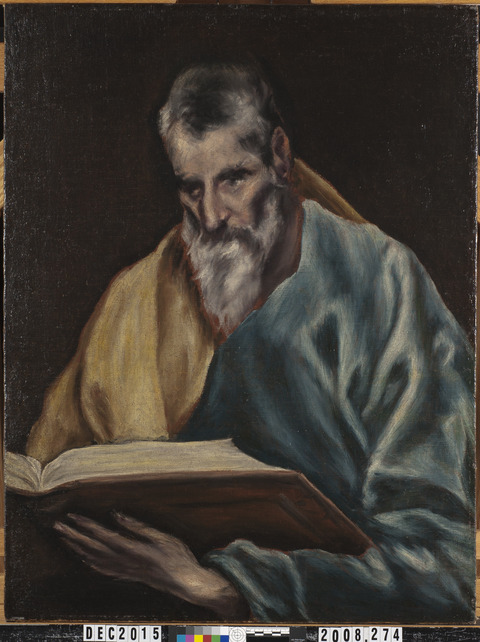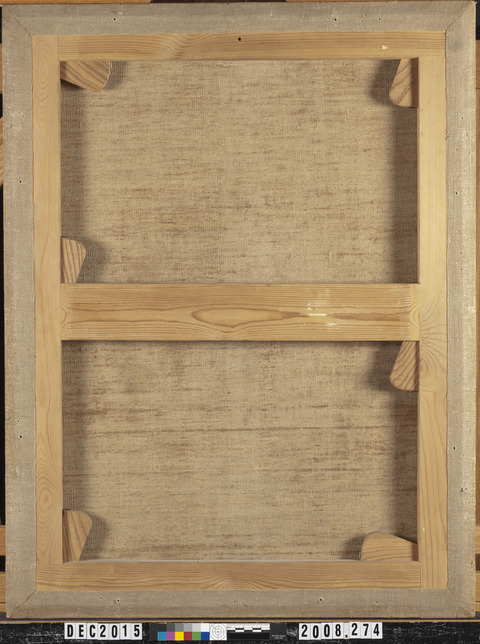Overview
Accession number: 2008.274
Artist: El Greco (Doménikos Theotokópoulos) and Workshop
Title: St. Simon
Materials: Oil (untested) on canvas
Date of creation: 1610–1614
Previous number/accession number: C10036
Dimensions: 81.8 × 55 cm
Conservator/examiner: Fiona Beckett with contributions from Roxane Sperber
Examination completed: 2016, revised 2019
Distinguishing Marks
Front:
Item 1. Painted initials in background near proper left shoulder. The upper portion of the signature appears to be original, however the lower portion extends over a loss and appears to be a reconstruction (tech. fig. 1).
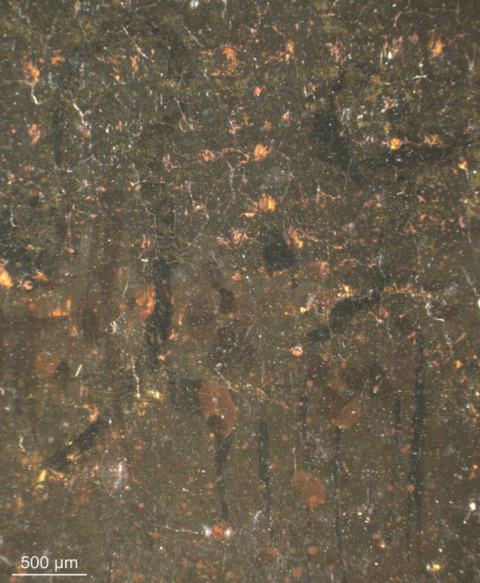
Back:
None
Summary of Treatment History
Letters between G.H.A. Clowes and the Newhouse Galleries, as well as the Fernando Álvarez de Sotomayor, the director of the Prado, reveal information about the conservation history of the painting before the works arrived at the IMA on long term loan in 1971. A letter from Álvarez de Sotomayor to Clowes states that the paintings were brought to the Prado where they were cleaned and relined before 1946.1
The painting was treated by Edward O. Korany in June 1952 for B.M. Newhouse before being purchased by Dr. Clowes. The treatment included cleaning, as referenced in a letter from Korany to Newhouse dated 20 December 1952.2 In a letter from Newhouse to Clowes, Newhouse states, “Despite the fact that these pictures require nothing but cleaning, it must be done very carefully and slowly and the man who is doing it can’t be hurried. If one attempts to hurry him it makes it all the worse and nothing is accomplished.” Newhouse offered to bring the paintings to Woods Hole for Clowes to see while he was visiting Easterly.3 It appears that he did just this because, in a letter from the following September, Newhouse tell Clowes that the paintings were sent back for a final varnishing due to blooming, “which generally happens if you take them away before the final coat of varnish has been applied."4 By October, Clyde Newhouse wrote to Clowes to confirm that the treatment on the El Grecos was finished and that the varnish looked magnificent.5
Documentation indicates a series of condition assessments and treatments were carried out on the collection at about the time the works were moved from the Clowes residence to the IMA in 1971. A condition report by Paul Spheeris in October of that year, likely carried out before the paintings were relocated, described the painting as having a chipped frame but that the painting was “O.K.” He recommended cleaning the work for the sake of its appearance but not for the safety of the painting.6 A second condition assessment was carried out upon arrival of the paintings at the IMA. This assessment describes the work as being in good condition and no work was deemed necessary.7
The painting was previously examined and documented in the Clowes Collection annual survey from 2011 to 2018.
Current Condition Summary
Aesthetically, the painting is in good condition and suitable for display. Structurally, the painting is also sound.
Methods of Examination, Imaging, and Analysis
| Examination/Imaging | Analysis (no sample required) | Analysis (sample required) |
|---|---|---|
| Unaided eye | Dendrochronology | Microchemical analysis |
| Optical microscopy | Wood identification | Fiber ID |
| Incident light | Microchemical analysis | Cross-section sampling |
| Raking light | Thread count analysis | Dispersed pigment sample |
| Reflected/specular light | X-ray fluorescence spectroscopy (XRF) | Fourier-transform infrared spectroscopy (FTIR) |
| Transmitted light | Macro X-ray fluorescence scanning (MA-XRF) | Raman microspectroscopy |
| Ultraviolet-induced visible fluorescence (UV) | ||
| Infrared reflectography (IRR) | Gas chromatography–mass spectrometry (GC-MS) | |
| Infrared transmittography (IRT) | Scanning electron microscope -energy dispersive X-ray spectroscopy (SEM-EDS) | |
| Infrared luminescence | Other: | |
| X-radiography |
Technical Examination
Description of Support
Analyzed Observed
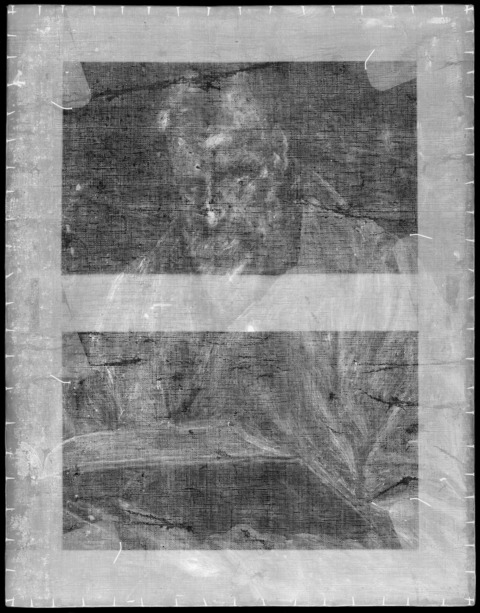
Material (fabric, wood, metal, dendrochronology results, fiber ID information, etc.):
The canvas is a plain weave canvas that is coarsely woven and incongruous (tech. fig. 2). The canvas is visible along the edges and appears to be linen. As discerned from the X-radiograph, the thread count is 11 × 10 threads/cm (tech. fig. 3).
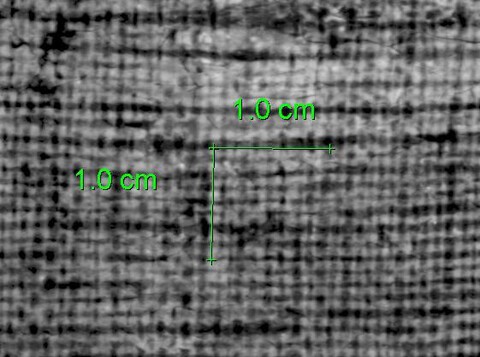
Characteristics of Construction / Fabrication (cusping, beveled edges of panels, seams, joins, battens):
The original tacking margins are present along the bottom edge and partially along the left edge, indicating that the painting remains close to its original size. A stiff glue-paste lining, performed at the Prado before 1946, was applied to the canvas, and brown paper tape is present along all edges. This does not appear to have been the first time the painting was lined as it was referred to as a “relining."8
Thickness (for panels or boards):
N/A
Production/Dealer’s Marks:
None
Attachment to Auxiliary Support:
The painting is secured to the stretcher via tacks along all four sides. In addition to tacks, the lining canvas was glued to the stretcher. Brown paper tape is present along all edges.
Auxiliary Support:
Original Not original Not able to discern None
The auxiliary support is a relatively new five-member stretcher with one horizontal crossbar with half laps at the joins. All six keys are present and held in place with finishing nails. The edges of the stretcher are rounded, and the crossbar is set back to prevent it from making contact with the canvas. The crossbar is also rounded at the edges.
Condition of Support
The auxiliary support is in good condition with all six keys present and no signs of any major damage. Slight wear is present from handling.
The original canvas support appears to be in stable condition. There is some fraying along the tacking margins. The adhesion between the original canvas and the lining canvas is intact. No tears can be observed in the X-radiograph (tech. fig. 2).
Description of Ground
Analyzed Observed
Materials/Binding Medium:
Likely a gypsum and lead white-based ground.
Color:
The ground color appears to be off-white, with a reddish brown imprimatura layer (or possibly a palette scrapings layer).9 The imprimatura layer has been left exposed in areas of the composition and along the tacking margins. It also gives the undertones to the paint layer and was deliberately left visible in the neck, edges of the blue robe, and in the skin tones.
Application:
The application is difficult to determine, but it appears likely that it was scraped over the surface of the canvas.
Thickness:
Appears to be thinly applied, as the canvas nubs remain visible
Sizing:
The canvas would likely have been sized prior to the application of the ground and paint layers.
Character and Appearance (Does texture of support remain detectable / prominent?):
The canvas texture remains prominent through the ground and paint layers. There is some weave interference from the lining canvas.
Condition of Ground
The ground layer appears to be in good condition. Some small losses are present throughout, as well as a few larger losses that were filled and retouched during a previous conservation campaign. The large losses include several horizontal losses in straight lines, consistent with a canvas that was once folded or rolled. This is particularly noticeable in the X-radiograph (see tech. fig. 4).

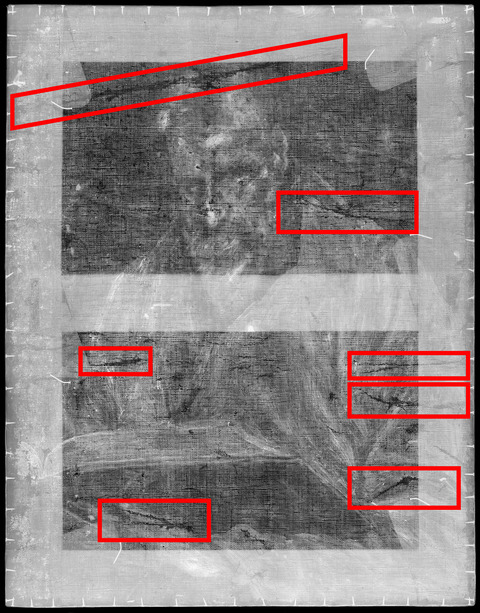
Description of Composition Planning
Methods of Analysis:
Surface observation (unaided or with magnification)
Infrared reflectography (IRR)
X-radiography
Analysis Parameters:
| X-radiography equipment | GE Inspection Technologies Type: ERESCO 200MFR 3.1, Tube S/N: MIR 201E 58-2812, EN 12543: 1.0mm, Filter: 0.8mm Be + 2mm Al |
|---|---|
| KV: | 20 |
| mA: | 3 |
| Exposure time (s) | 150 |
| Distance from X-ray tube: | 36″ |
| IRR equipment and wavelength | Opus Instruments Osiris A1 infrared camera with InGaAs array detector operating at a wavelength of 0.9–1.7µm. |
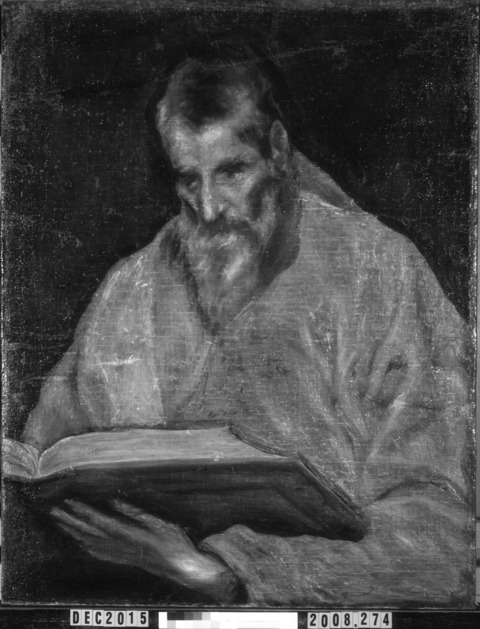
Medium/Technique:
No underdrawing is visible using infrared reflectography (tech. fig. 5). Some underpainting appears to be present and is visible as dark brushwork in the reflected infrared image. During his later work, El Greco used black sketchy lines similar to these.10 Slight variations of the composition are visible, such as in the folds of the clothing. This type of brushwork is also visible in the upper paint layers, although here it is more subdued.
Pentimenti:
None apparent
Description of Paint
Analyzed Observed
Application and Technique:
The paint was applied with a quick and efficient technique. Of the three El Greco saints in the Clowes Collection, this picture is perhaps the least finished. The blending of edges is slightly more rough and the building up of form is less developed. The background appears to have been applied first, leaving a rough reserve for the figure and book. The areas of color were painted using loose, sweeping strokes of bright color composed of three tones to create the midtones, highlights, and shadows. In the blue robe, pure white is used for the highlights. The skin and hair were painted in similarly loose, yet confident strokes. A considerable gap revealing reddish imprimatura is visible between the blocks of color and areas of skin. This is in contrast to the St. Matthew painting, which exhibits crisp edges that closely overlap. This may suggest the drapery and skin were painted by different hands within the workshop. The imprimatura also functions to deepen the areas of shadow. Final outlining in black paint is present around the hands, drapery, and features of the saint, and is also utilized to deepen the shadows.
When viewed under a microscope, the paint surface and brushwork are indicative of wet-in-wet technique. The paint was applied in sweeping brushstrokes that were quickly and confidently executed. The paint does not appear to have been mixed prior to the application, but was later mixed on the canvas while establishing the composition. This can be seen in the area of the ear.
Painting Tools:
Medium to large brushes
Binding Media:
Oil (untested)
Color Palette:
The painting uses a limited color palette of primarily earth tones with passages of yellow and blue. XRF analysis identified significant peaks for lead, iron, tin, magnesium, and copper. This suggests the artist used a color palette rich in lead white, iron oxide (earth pigments), azurite (and/or malachite), and lead-tin yellow. The bright passages of yellow and blue appear to have been painted primarily with mixtures of lead white with lead-tin yellow and azurite, respectively. Traces of manganese were found in areas with significant iron peaks. The peak for manganese was significant in the background, suggesting umber pigments were used in greater quantities in this area (tech. fig. 6, sample 5). This palette is consistent with that available during El Greco’s lifetime.
XRF Analysis:
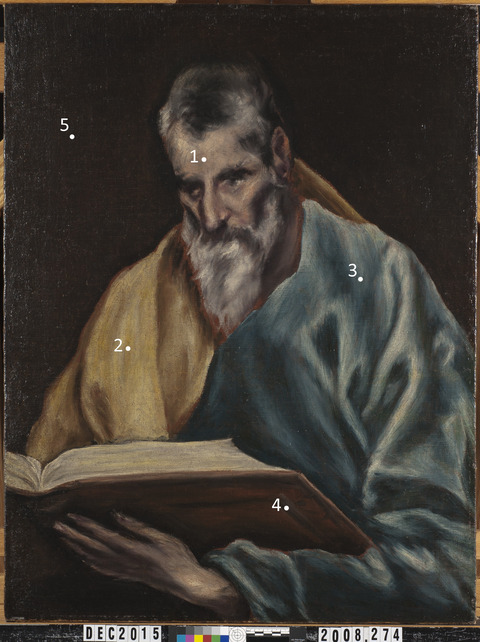
| Sample | Location | Elements | Possible Pigments |
|---|---|---|---|
| 1 | Skin tone in forehead | Major: Pb Minor: Cu, Ca, Fe Trace: K, Ti, Mn | Lead white, azurite (or malachite), calcium (from ground layer), iron oxide (earth pigments including umber). |
| 2 | Yellow in garment | Major: Pb, Cu, Fe Minor: Ca, Sn Trace: Mn | Lead white, lead-tin yellow, iron oxide (earth pigments including umber), azurite (or malachite), calcium (from ground layer). |
| 3 | Blue in garment | Major: Cu, Pb, Fe Minor: Ca Trace: Mn, Ti, K | Azurite, lead white, iron oxide (earth pigments including umber), calcium (from ground layer). |
| 4 | Brown in book | Major: Pb, Fe, Cu Minor: Ca Trace: K, Si, Ti | Iron oxide (earth pigments), lead white, azurite (or malachite), calcium (from ground layer), titanium from impurity (or retouching). |
| 5 | Brown-black in background | Major: Pb, Fe, Cu Minor: Ca, Mn Trace: K, Ti | Iron oxide (earth pigments including umber), lead white, azurite (or malachite), calcium (from ground layer). |
Table 1: Results of X-ray fluorescence analysis conducted with a Bruker Artax microfocus XRF with rhodium tube, silicon-drift detector, and polycapillary focusing lens (~100μm spot).
*Major, minor, trace quantities are based on XRF signal strength not quantitative analysis.
Surface Appearance:
The brushwork has definitive ridges and texture, some of which has been worn away or flattened from previous treatments.
Condition of Paint
A micro-cracking pattern from natural aging extends over the entire painting. Small paint losses are scattered throughout the painting, as well as some larger losses that have been subsequently retouched during a recent conservation campaign. The larger losses appear to be from when the canvas was rolled either for storage or transport. Wear is visible around the perimeter of the painting where the paint is in contact with the frame. Embedded dirt is present throughout the painting.
Description of Varnish/Surface Coating
Analyzed Observed Documented
| Type of Varnish | Application |
|---|---|
| Natural resin | Spray applied |
| Synthetic resin/other | Brush applied |
| Multiple layers observed | Undetermined |
| No coating detected |
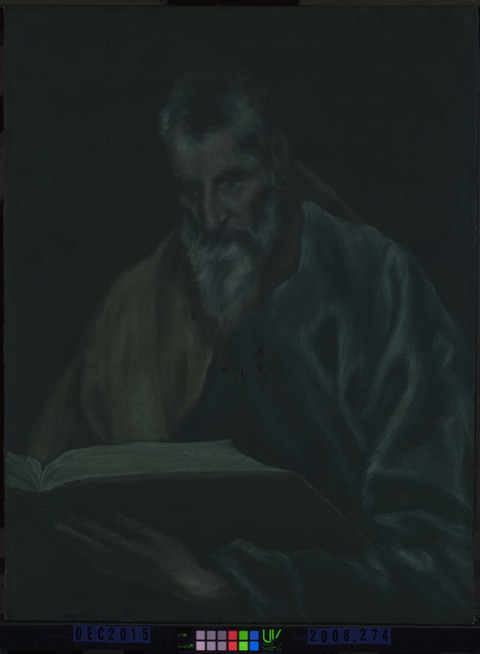
Imaging with ultraviolet-induced visible fluorescence reveals the characteristic greenish fluorescence of an aged natural resin varnish (tech. fig. 7). It appears to be pooling in some of the lower valleys of the paint surface. The painting was also spray varnished with a synthetic coating during a later conservation campaign.
Condition of Varnish/Surface Coating
The natural resin varnish is slightly yellowed (tech. fig. 7), but this is not overly distracting. A few small scuffs and minor losses are visible, particularly around the perimeter where the painting is in contact with the frame. The varnish is otherwise intact and adequately saturates the surface of the painting.
Retouching is also present in several areas of the painting, particularly in the losses and background, where it appears to have been retouched using a “spritzing”' method.
Description of Frame
Original/first frame
Period frame
Authenticity cannot be determined at this time/ further art historical research necessary
Reproduction frame (fabricated in the style of)
Replica frame (copy of an existing period frame)
Modern frame
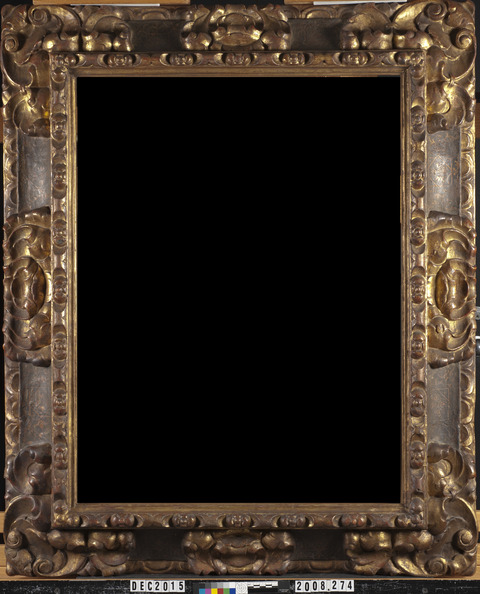
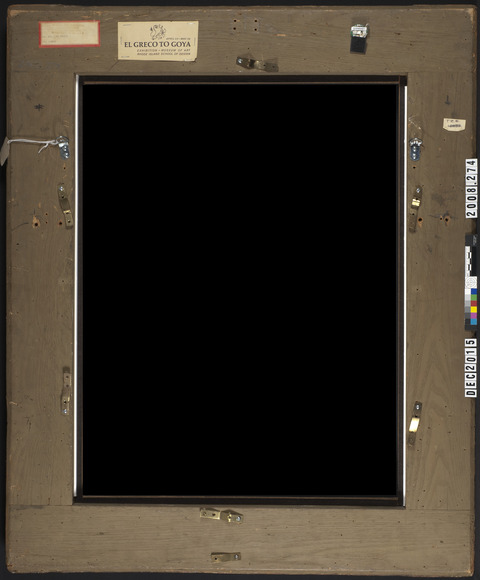
Frame Dimensions:
Outside frame dimensions: 98 × 81.5 × 8 cm
Sight size: 54 × 70.5 cm
Distinguishing Marks:
Item 2. Off-white exhibition label, back of left member: “April 20–May 26 El Greco to Goya Exhibition – Museum of Art Rhode Island School of Design” (tech. fig.9).
Item 3. White label with red border, back of upper frame member: “The Clowes Fund Incorporated Fine Arts department 3744 Spring hollow Road Indianapolis 8 INDIANA USA No. 24 EL GRECO ST. SIMON” (tech. fig. 9).
Description of Molding/Profile:
The frame is of carved wood with a painted and gilded surface (tech. fig. 8). The frame is very similar to the one on St. Matthew in the Clowes Collection. Timothy Newbery described the stencil design on the painted black portions of this frame as having “a strapwork beaded reel reminiscence [sic] of pomegranate wall covering decorations.”
Condition of Frame
The frame is in relatively good condition.
Notes
-
Letter from Fernando Álvarez de Sotomayor to G.H.A. Clowes, 21 November 1952, Correspondence Files, Clowes Registration Archive, Indianapolis Museum of Art at Newfields. ↩︎
-
Letter from Edward O. Korany to B.M. Newhouse, 20 December 1952, Conservation Department Files, Indianapolis Museum of Art at Newfields. ↩︎
-
Letter from Bert Newhouse to G.H.A. Clowes, 9 June 1952, Correspondence Files, Clowes Registration Archive, Indianapolis Museum of Art at Newfields. ↩︎
-
Letter from Bert Newhouse to G.H.A. Clowes, 16 September 1952, Correspondence Files, Clowes Registration Archive, Indianapolis Museum of Art at Newfields. ↩︎
-
Letter from Clyde Newhouse to G.H.A. Clowes, 25 October 1952, Correspondence Files, Clowes Registration Archive, Indianapolis Museum of Art at Newfields. ↩︎
-
Paul A.J. Spheeris, “Conservation Report on the Condition of the Clowes Collection,” 25 October 1971, Conservation Department Files, Indianapolis Museum of Art at Newfields. ↩︎
-
Martin Radecki, Clowes Collection condition assessment, undated (after October 1971), Conservation Department Files, Indianapolis Museum of Art at Newfields. ↩︎
-
Letter from Fernando Álvarez de Sotomayor to G.H.A. Clowes, 21 November 1952, Correspondence Files, Clowes Registration Archive, Indianapolis Museum of Art at Newfields. ↩︎
-
Mixed references exist with regards to palette scrapings. Some sources identify them in El Greco’s painting and others specify a selection of materials. The Clowes painter appears to have used a combination of dark reddish colors in his palette to achieve the reddish-brown color and then applied that to the painting both to be economical and to achieve the toned ground. However, a cross-section sample would be necessary to confirm the composition of this layer. See “El Greco from Italy to Toledo: Technical Study of the Works in the Thyssen-Bornemisza Collection,” Museo Thyssen-Bornemisza website (2014), http://www2.museothyssen.org/microsites/exposiciones/2014/el-greco/evolucion-tecnica-pictorica-1.php?lang=en, and Juan Pantoja de la Cruz, “Technical Investigation and Restoration: The Evolution of Preparations for Painting on Canvas in Sixteenth-Century Spain,” Boletín del Museo del Prado 28, no. 46 (2010): 39–59 (English translation),
https://www.museodelprado.es/en/learn/research/studies-and-restorations/resource/the-evolution-of-preparations-for-painting-on/39cd7ac1-b445-49da-9362-61dbc19c5ed8. ↩︎
-
Susanna P. Griswold, “Two Paintings by El Greco: Saint Martin and the Beggar,” Studies in the History of Art 41 (1993): 133, 140–148. ↩︎
Additional Images
